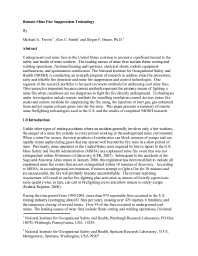Mining Publication: Remote Mine Fire Suppression Technology
Original creation date: November 2007
Underground coal mine fires in the United States continue to present a significant hazard to the safety and health of mine workers. The leading causes of mine fires include flame cutting and welding operations, frictional heating and ignitions, electrical shorts, mobile equipment malfunctions, and spontaneous combustion. The National Institute for Occupational Safety and Health (NIOSH) is conducting an in-depth program of research to address mine fire prevention, early and reliable fire detection and mine fire suppression and control technologies. One segment of the research portfolio is focused on remote methods for addressing coal mine fires. This research is important because remote methods represent the primary means of fighting a mine fire when conditions are too dangerous to fight the fire directly underground. Technologies under investigation include remote methods for installing ventilation control devices (mine fire seals) and remote methods for suppressing the fire using, the injection of inert gas, gas-enhanced foam and jet engine exhaust gases into the fire zone. This paper presents a summary of remote mine firefighting technologies used in the U.S. and the results of completed NIOSH research.
Authors: MA Trevits, AC Smith, JF Brune
Conference Paper - November 2007
NIOSHTIC2 Number: 20032690
Proceedings of the 32nd International Conference of Safety in Mines Research Institutes, 28-29 September 2007, Beijing, China. Beijing, China: National Center for International Exchange & Cooperation on Work Safety (SAWS), 2007; :306-312
See Also
- Effectiveness of Various Concentrations of an Inert Gas Mixture for Preventing and Suppressing Mining Equipment Cab Fires: Development of a Dual-Cab Fire Inerting System
- Evaluation of the Bagged Stone Dust Barrier Effectiveness in a Bord and Pillar Mine
- Inflatable Partitions for High-Expansion Foam Generators
- Mine Fires - Measuring the Efficacy of Gas-Enhanced Foam
- Progress Toward Improved Engineering of Seals and Sealed Areas of Coal Mines
- Safe and Economical Inerting of Sealed Mine Areas
- Smoke, Carbon Monoxide, and Hydrogen Chloride Production from the Pyrolysis of Conveyor Belting and Brattice Cloth
- The Status of Mine Fire Research in the United States
- Understanding Mine Fire Disasters by Determining the Characteristics of Deep-Seated Fires
- Use of Rocsil® Foam to Remotely Construct Mine Seals
- Page last reviewed: 9/21/2012
- Page last updated: 9/21/2012
- Content source: National Institute for Occupational Safety and Health, Mining Program


 ShareCompartir
ShareCompartir
